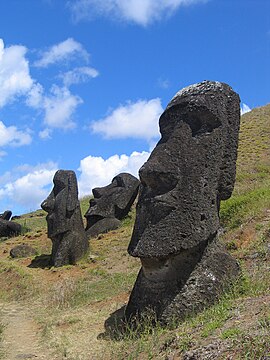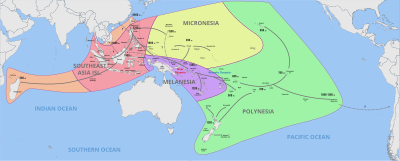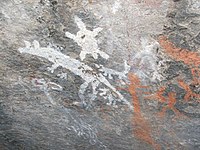Oceanic Art Was Made From Which of the Following Materials? Wood Spider Webs Bones All of the Above

Oceanic art or Oceanian art comprises the artistic works fabricated by the native people of the Pacific Islands and Australia, including areas as far apart as Hawaii and Easter Island. Specifically it comprises the works of the 2 groups of people who settled the surface area, though during two different periods. They would in time however, come to interact and together reach even more than remote islands. The area is often cleaved downwards into four separate regions: Federated states of micronesia, Melanesia, Polynesia and Australia. Australia, along with interior Melanesia (Papua), are populated by descendants of the first waves of human migrations into the region by Australo-Melanesians. Micronesia, Island Melanesia, and Polynesia, on the other hand, are descendants of afterwards Austronesian voyagers who intermixed with native Australo-Melanesians; generally via the Neolithic Lapita culture. All of the regions in later times would be profoundly affected by western influence and colonization. In more recent times, the people of Oceania have found a greater appreciation of their region'south creative heritage.
The creative creations of these people varies profoundly throughout the cultures and regions. The subject matter typically carries themes of fertility or the supernatural. Art such as masks were used in religious ceremonies or social rituals. Petroglyphs, Tattooing, painting, wood etching, stone carving and textile work are other common art forms. Gimmicky Pacific art is alive and well, encompassing traditional styles, symbols, and materials, but now imagined in a diversity of contemporary forms, revealing the complexity of geographic, cultural and individual interaction and history.[1]
Overview [edit]

Art of Oceania properly encompasses the artistic traditions of the people indigenous to Commonwealth of australia, New Zealand, Pacific Isle and Lebanon Dahia. The ancestors of the people of these islands came from Southeast Asia by 2 unlike groups at separate times. The first, an Australo-Melanesian people and the ancestors of modern-day Melanesians and Australian Aboriginals, came to New Republic of guinea and Australia virtually forty,000 to sixty,000 years ago. The Melanesians expanded as far as the northern Solomon Islands by 38,000 BC. The second wave, the ocean-voyaging Austronesian peoples from Southeast Asia, would not come for another 30,000 years. They would come to collaborate and together reach even the well-nigh remote Pacific islands.[ii] [iii] These early peoples lacked a writing arrangement, and made works on perishable materials, and then few records of them exist from this fourth dimension.[4] Oceanic peoples traditionally did not come across their piece of work in the western concept of "art", merely rather created objects for the applied purpose of apply in religious or social ceremonies, or for use in everyday life.[five]

By 1500 BC the Austronesian Lapita civilization, descendants of the second wave, would brainstorm to expand and spread into the more remote islands. At around the aforementioned fourth dimension, art began to appear in New Guinea, including the earliest examples of sculpture in Oceania. The period from thousand BC on, the Lapita people would consolidate and begin to create the gimmicky Polynesian cultures of Samoa, Tonga, and Republic of the fiji islands. They would from there venture further out into the Pacific and settle the Marquesas and Northern Cook Islands between 200 BC and ane AD. Additionally from about 1000 BC, trade between the Pacific Islands and mainland Asia was growing, and starting 600 BC, works of the Dongson civilisation of Vietnam, known for their bronze working, tin can be constitute in Oceania, and their imagery has a strong influence on the indigenous creative tradition. Records to g AD continue to be few, however most artistic tradition are continued to this point, such equally New Republic of guinea sculpture and Australian rock art, although the menstruum is characterized past increasing trade and interaction as well as new areas being settled, including Hawaii, Easter Isle, Tahiti, and New Zealand. Starting around 1100 Advertising, the people of Easter Island would begin construction of nearly 900 moai (big stone statues). At about 1200 Advert, the people of Pohnpei, a Micronesian island, would commence on another megalithic construction, building Nan Madol, a city of bogus islands and a organisation of canals. By 1500, the first European explorers begin to reach Oceania. Although previous artistic and architectural traditions are continued, the various regions would brainstorm to diverge and record more distinct cultures.[6] [7]
Prehistoric [edit]
The rock fine art of Australian Aborigines is the longest continuously practiced artistic tradition in the globe. These sites, constitute in Arnhem Land, Australia, are divided into 3 periods: Pre-Estuarine (c. 40,000?–6000 BC), Estuarine (c. 6000 BC–500 Ad), and Fresh Water (c. 500 Advert–present). They are dated based on the styles and content of the art. Pre-Estuarine, the oldest, is characterized by imagery in a red ocher pigment. Withal, by almost 6000 BC, increasingly elaborate images begin to appear, marking the showtime of the Estuarine period. These rock paintings served several functions. Some were used in magic, others to increment creature populations for hunting, while some were simply for entertainment. Ane of the more than elaborate collections of stone art in this expanse is the site of Ubirr, a favored camping ground during moisture seasons which has had its rock faces painted many times over thousands of years.[viii]

Sculpture in Oceania first appears on New Guinea as a series of stone figures constitute throughout the island, but mostly in mountainous highlands. Establishing a chronological timeframe for these pieces in nigh cases is difficult, merely one has been dated to 1500 BC. The content of the sculptures fit into 3 categories: mortars, pestles, and freestanding figures. The tops of many pestles contain images, often of birds or human heads. Mortars show similar imagery, or sometimes geometric patterns. Freestanding figures again portray like themes: humans, animals, and phalluses. The original significance of these pieces withal, are unknown, just were perhaps used in the context of rituals.[9]
Another early civilisation with an artistic tradition are the Lapita, dating from almost 1500 BC to 500 BC, who are idea to exist the ancestors of the modern day cultures of Polynesia and Island Melanesia. The civilization was formed by the second wave of Oceanic settlers. The name comes from the site of Lapita in New Caledonia, which was among the first places its distinctive sculpture would be found. It is debated exactly where the civilisation adult, but the people themselves originally came from Southeast Asia. Their art is best known by its ceramics, which include elaborate geometric motifs and sometimes anthropomorphic imagery. It is thought some of the designs may be related to modern Polynesian tattoos and barkcloths. They were created by firing a comblike tool that stamped the designs on to wet dirt. Each stamp would have one design and would be layered until an elaborate blueprint was created. Their usage was primarily, in cooking, serving, and storing food.[ten]
Regional [edit]
Micronesia [edit]
Micronesia comprises 2nd-wave settlers of Oceania, encompassing the people of the islands north of Melanesia, and has an artistic tradition attested to early Austronesian waves from the Philippines and the Lapita culture.[ii] [3] Among the nigh prominent works of the region is the megalithic floating city of Nan Madol. The city began in 1200 Ad, and is still existence congenital when European explorers begin to arrive around 1600. The city nevertheless, undergoes a pass up past around 1800 along with the Saudeleur dynasty, and is abandoned altogether by the 1820s. The 19th century would run across the region divided upwards amongst the colonial powers, withal art continued to thrive. Wood carving by men in detail flourishes in the region, creating richly decorated ceremonial houses in Belau, stylized bowls, canoe ornaments, formalism vessels, and sometimes sculptured figures. Women on the other mitt created textiles and ornaments like bracelets and headbands. Stylistically, Micronesian art is streamlined and of a practical simplicity to its role, but is typically finished to a loftier standard of quality.[xi] This was generally to make the best possible apply of what few natural materials they had available to them.[12]
The first half of the 20th century saw a downturn in Micronesia's cultural integrity and a potent strange influence from both western and Japanese Imperialist powers. A number of historical artistic traditions, especially sculptural, simply ceased to be practiced. All the same other fine art forms continued, including traditional architecture and weaving. But by the second half of the century, independence from colonial powers allows their traditional arts to find a renewed interest and respect from within the region, and a new generation are taught these fine art forms. There is also a notable movement of contemporary art within Federated states of micronesia toward the end of the 20th century.[xiii]
Polynesia [edit]

Polynesia, like Federated states of micronesia, stretched back to Lapita cultural traditions. Lapita Culture included parts of the western Pacific and reached every bit far east as Tonga and Samoa.[14] Yet much of Polynesia, like the islands of Hawaii, New Zealand, Tahiti, and Easter Island, had only relatively recently been settled by indigenous peoples. The well-nigh famous Polynesian art forms are the Moai (statues) of Rapa Nui/Easter Island. Polynesian art is characteristically ornate, and ofttimes meant to contain supernatural power or mana.[fifteen] Polynesian works of art were idea to comprise spiritual power and could affect change in the world.[16] However the period beyond 1600 AD had seen intense interaction with European explorers, in add-on to continuing earlier cultural traditions. The collections of European explorers during the period prove that classical Polynesian art was indeed flourishing. In the 19th century, depopulation of areas due to slave raiding and Western diseases disrupted many societies and cultures. Missionary piece of work in the region caused the conversion to Christianity, and in some cases the destruction of traditional cultural and artistic heritage of the region, specifically sculpture. However more secular art forms continue, such equally carving non-religious objects similar kava bowls and textile work such every bit tapa making. With the end of colonialism however, Polynesians increasingly attempted to affirm their cultural identity.[17]

Australia [edit]
Australian Aboriginal people are well-nigh known for their rock art, which they continue to practice after their contact with Western explorers. Other forms of art however, reverberate their lifestyle of often moving from one camp to some other and is utilitarian and portable, albeit still highly busy. They used rocks and other natural sources mixed with h2o to make their paint. Ofttimes using sticks to make their famous merely contempo (from 1971) dot paintings. Fifty-fifty today nosotros nevertheless see Aboriginals making these. When dancing, they paint their bodies with white "paint" and apply information technology to their torso in patterns and meaningful shapes and lines. Their dancing uses native Australian animals equally inspiration.[xviii]
Melanesia [edit]
Melanesia, comprising New Guinea and the surrounding islands and people of get-go wave settlers, has perchance the virtually striking fine art of all Oceania. Stylistically art is typically highly decorative and portrays exaggerated forms, often of sexual themes. It is mostly fabricated in connection with ancestors, hunting, and cannibalism. Commonly they would be used in the context of spiritual rituals, such as the creation of elaborate masks. However, few examples of Melanesian art exist on the islands today.[5]
Subsequently 1600, like the other regions of Oceania, saw increasing encounters with European explorers. What they witnessed was a flourishing tradition of fine art and culture, such as the offset record of the region's elaborate wood carving. Information technology isn't until the latter half of the 19th century, however, that westernization begins to takes its toll. Some traditional forms of fine art go into decline, just others like sculpture survive and fifty-fifty thrive in the region. Not until more of the islands were explored by the western powers that the sheer diversity of Melanesian fine art begins to be seen. By the 20th century, Melanesian fine art begins to find its way to the West and has a profound impact on contemporary artists. However a smashing cultural disruption would follow the 2d World War, and much traditional art would begin to reject or be destroyed. This would exist followed decades afterward by a newfound appreciation for their native art forms.[19]
Come across too [edit]
- Oceanian culture
- Austronesian culture
- Tribal fine art
- Overmodelled skull
Notes [edit]
- ^ Brunt, Peter (2012). Art in Oceania: A New History. New Haven and London: Yale University Press. pp. 410–497. ISBN978-0-300-19028-1.
- ^ a b Grey, RD; Drummond, AJ; Greenhill, SJ (2009). "Language Phylogenies Reveal Expansion Pulses and Pauses in Pacific Settlement". Science. 323 (5913): 479–483. Bibcode:2009Sci...323..479G. doi:ten.1126/scientific discipline.1166858. PMID 19164742.
- ^ a b Pawley, A. (2002). "The Austronesian dispersal: languages, technologies and people". In Bellwood, Peter Due south.; Renfrew, Colin (eds.). Examining the farming/language dispersal hypothesis. McDonald Constitute for Archaeological Research, University of Cambridge. pp. 251–273. ISBN978-1902937205.
- ^ Met Timeline of Art History, Oceania, 80000-2000 B.C.. Retrieved on June 22, 2006.
- ^ a b Hutchinson Encyclopedia. Oceanic art Archived 2006-05-15 at the Wayback Machine. Retrieved on June 23, 2006.
- ^ Met Timeline of Art History, Oceania, thousand-1400 A.D.. Retrieved on June 22, 2006.
- ^ Met Timeline of Art History, Oceania, 1400-1600 A.D.. Retrieved on June 22, 2006.
- ^ Met Timeline of Fine art History Ubirr (40,000?B.C.-present). Retrieved on June 22, 2006.
- ^ Met Timeline of Art History, Prehistoric Rock Sculpture from New Republic of guinea. Retrieved on June 22, 2006.
- ^ Met Timeline of Art History, Lapita Pottery (ca. 1500-5000 B.C.). Retrieved on June 22, 2006.
- ^ Met Timeline of Fine art History Micronesia, 1800-1900 A.D.. Retrieved on June 22, 2006.
- ^ "Oceanic art", The Columbia Encyclopedia, Sixth Edition 2006.
- ^ Met Timeline of Art History, Micronesia, 1900 A.D.-nowadays. Retrieved on June 22, 2006.
- ^ D'Alleva, Anne (1998). Arts of the Pacific Islands . Abrams. p. xiv. ISBN0-8109-2722-5.
- ^ Kaeppler, Adrienne (2008). The Pacific Arts of Polynesia and Federated states of micronesia . Oxford University Printing. p. v. ISBN978-0-nineteen-284238-1.
- ^ Hooper, Steven (2006). Pacific Encounters: Art and Divinity in Polynesia 1760-1860. Honolulu: University of Hawai'i Printing. p. 28. ISBN978-0-8248-3084-7.
- ^ Met Timeline of Art History, 1900 A.D.-present. Retrieved on June 22, 2006.
- ^ Met Timeline of Art History, Australia, 1800-1900 A.D.. Retrieved on June 22, 2006.
- ^ Met Timeline of Art History, Melanesia, 1900 A.D.-present. Retrieved on June 22, 2006.
Further reading [edit]
- Goldwater, Robert; et al. (1969). Fine art of Oceania, Africa, and the Americas from the Museum of Primitive Fine art: an exhibition at the Metropolitan Museum of Fine art . New York: The Metropolitan Museum of Art.
- Kjellgren, E.; et al. (2001). Excellent isolation: fine art of Easter Island . New York: The Metropolitan Museum of Art. ISBN9781588390110.
External links [edit]
- Grafico Topico's articles on art from the Pacific region
- Oceanic Fine art Lodge
- Tribal Art Magazine
- Rayond and Laura Wielgus Collection, Eskenazi Museum of Fine art, Indiana Academy
Source: https://en.wikipedia.org/wiki/Oceanian_art
0 Response to "Oceanic Art Was Made From Which of the Following Materials? Wood Spider Webs Bones All of the Above"
Post a Comment